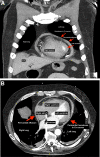Great cardiac vein injury after circumflex artery intervention: a case report
- PMID: 37601229
- PMCID: PMC10433094
- DOI: 10.1093/ehjcr/ytad335
Great cardiac vein injury after circumflex artery intervention: a case report
Abstract
Background: Injury of the great cardiac vein (GCV) during circumflex coronary artery intervention is not discussed enough in the literature. In addition, relationship between the GCV and circumflex artery is highly variable and practically unpredictable in 30% of cases. This report describes a rare case of GCV injury during circumflex artery intervention.
Case summary: An 80-year-old man with known ischaemic heart disease was admitted with unstable anginal pain for urgent coronary angiography. Circumflex (Cx) percutaneous coronary intervention (PCI) of proximal-to-medial high-grade calcified stenosis was performed. Two hours later, the patient developed pericardial tamponade. Pericardiocentesis revealed a venous bloody effusion. Due to continuous bleeding, an urgent exploratory thoracotomy was performed. Intraoperatively, a large pericardial haematoma in the Cx region was evacuated. The perforation site was sought and identified as a tear at the GCV. Further hospitalization was uneventful, and the patient was discharged after one week. Clinical and echocardiographic outcomes were favourable at the 3-month follow-up.
Discussion: A GCV injury during PCI is a diagnosis of exclusion if there is a venous pericardial effusion directly after PCI and no injury of the right ventricle or surrounding structures, and thoracic computed tomography demonstrates a pericardial haematoma in the PCI region, especially the Cx region. A haematoma can deteriorate the haemodynamic status without effusion 'dry tamponade'. Treatment should be addressed according to haemodynamics. A conservative therapy, pericardiocentesis, catheter-based bailout intervention or even an explorative pericardiotomy could be imperative to evacuate the haematoma and seal the injured vein.
Keywords: Calcific lesion; Case report; Circumflex artery; Great cardiac vein; Pericardial effusion.
© The Author(s) 2023. Published by Oxford University Press on behalf of the European Society of Cardiology.
Conflict of interest statement
Conflict of interest: None declared.
Figures






Similar articles
-
Mediastinal effusion due to pericardiocentesis with cardiac tamponade: a case report.BMC Anesthesiol. 2021 Jun 16;21(1):172. doi: 10.1186/s12871-021-01385-8. BMC Anesthesiol. 2021. PMID: 34134618 Free PMC article.
-
Coronary artery perforation secondary to lifesaving pericardiocentesis for cardiac tamponade: a case report.BMC Cardiovasc Disord. 2021 Jan 28;21(1):55. doi: 10.1186/s12872-021-01875-0. BMC Cardiovasc Disord. 2021. PMID: 33509075 Free PMC article.
-
A case of double coronary perforations and tamponade during left main percutaneous coronary intervention and treatment with stenting and autotransfusion.Turk Kardiyol Dern Ars. 2013 Jan;41(1):68-71. doi: 10.5543/tkda.2013.43503. Turk Kardiyol Dern Ars. 2013. PMID: 23518943
-
Pericardial tamponade after chronic total occlusion revascularization: a case report and literature review.Ann Palliat Med. 2021 Jul;10(7):8506-8511. doi: 10.21037/apm-20-2455. Epub 2021 Jul 7. Ann Palliat Med. 2021. PMID: 34263610 Review.
-
Management strategies in pericardial emergencies.Herz. 2006 Dec;31(9):891-900. doi: 10.1007/s00059-006-2937-0. Herz. 2006. PMID: 17180653 Review.
References
-
- Stankovic G, Orlic D, Corvaja N. Incidence, predictors, in-hospital, and late outcomes of coronary artery perforations. Am J Cardiol 2004;93:213–216. - PubMed
-
- Pejkovic B, Bogdanovic D. The great cardiac vein. Surg Radiol Anat 1992;14:23–28. PMID: 1589843. - PubMed
-
- Saremi F, Muresian H, Sánchez-Quintana D. Coronary veins: comprehensive CT-anatomic classification and review of variants and clinical implications. Radiographics 2012;32:E1– 32. PMID: 22236907. - PubMed
Publication types
LinkOut - more resources
Full Text Sources
Miscellaneous
